December 2, 1982
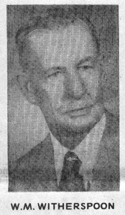
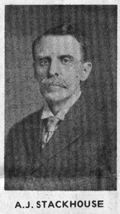
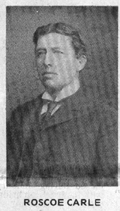
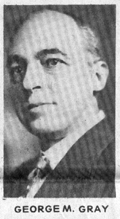
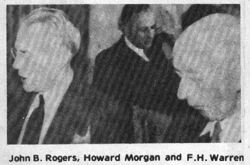
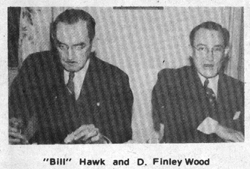
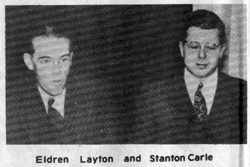
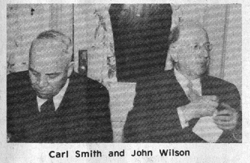
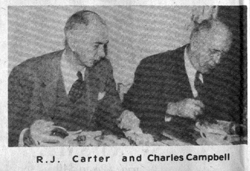
Picture #1 (missing) – Present and graduate members of the University Club include top row, left to right: Richard Norton, Frank Kinn, Vic Scheiber; second row: Mel Murray, Richard Carter, Robert Fast, Charles Pritchard, Ladislay Javornik, Jay Shiff, Duane Richardson; third row: Donald M. Mennel, Richard Fisher, Herbert Ford, Arnold Lundberg (all graduate members); first row: Donald L. Mennel, Tom Gray, Eugene Schalk, Emmet Sheeran. Roger Wise, a member, was missing when the photo was taken.
Very early members of University Club.
Picture #2 – W.M. Witherspoon
PIcture #3 – A.J. Stackhouse
Picture #4 – Roscoe Carle
Picture #5 – George M. Gray
University Club members at dinner Dec. 18, 1941, taken by Gordon Gray.
Picture #6 – John B. Rogers, Howard Morgan and F.H. Warren
Picture #7 – “Bill” Hawk and D. Finley Wood
Picture #8 – Eldren Layton and Stanton Carle
Picture #9 – Carl Smith and John Wilson
Picture #10 – R.J. Carter and Charles Campbell
It’s time to tell readers about The University Club, an organization of men in Fostoria, organized Jan. 30, 1908, and still effectively functioning, according to its original precepts.
Preliminary meetings, prior to organization, were held at 336 S. Main St., the home of Dr. C.N. Hatfield, where Mrs. Hatfield (Edna) and daughter, Helene, lived for many years until their recent deaths.
J.D. Asire took an active part during the organization period and probably some of the preliminary meetings were held at that home at 325 S. Main St. Asire and his father were undertakers (morticians).
Thirty years later (1938) Fred Warren, superintendent of schools, in a paper prepared for delivery at a regular meeting, reminded members what the organizing group considered and incorporated in its constitution.
ORIGIN OF NAME
“University Club…the name ‘university’ has no allusion to the higher colleges of that name, or even to higher education or to the college qualifications of members. It corresponds to use of the name by ancient workmen’s guilds: ‘University’…(Latin, ‘uni’– one, plus ‘bertere,’ ‘versum’ to turn) equals ‘to turn into one,’ and may be freely defined as a ‘self-centered group of persons associated in a distinct province of thought and investigations.
“The club motton–‘Investigate.’
“The club badge–upper button of vest unfastened (‘in vest, a gate’); a symbol or sign of unbosoming one’s self in a company of close friends.
“Object–“the increase and diffusion of knowledge among its members.
“Method–The preparation and presentation of 30-minute papers on selected subjects by each member and discussions by all members; travelogues by members; lectures by non-members.
SMALL MEMBERSHIP
“Membership–Not to exceed 15 male residents of Fostoria, Ohio; that number considered large enough to include all eligible at any one time, and small enough to afford a sufficient forum. Active members of four or more years may become graduate members at their request.
Unlike the names of their counterparts in most organizations, the officers are regent, vice-regent, chronicler, bursar. Regular meetings are held semi- monthly, but not during summer months.
No attempt will be made to publish Mr. Warren’s complete paper of 1938, however, in his own inimitable style, here are a few of his remarks that will help readers get a clearer view of the club and its members.
“The history of this club has been long and honorable. No one has ever been a member of the club without being benefited by it, and without making a contribution to it. There is a unity and an ideal that binds us together. And yet no two of us are alike…thank goodness.
“We usually have no axes to grind, but if we do we grind them well.”
TOAST THE LADIES
“We toast the ladies three times a year and roast them between times.
“We serve the community by advancing intelligence and broadening the outlook.
“We are pacifists until someone steps on our toes.
“We are knights of old with armor that shines from within.
“We are religious as only men of intelligence and vision can be.
“Our membership is cosmopolitan. We include no only university men but also, figuratively speaking, the butcher, the baker, the candlestick maker…the latter always being graduates of the University of Hard Knocks.”
In the preparation of this article I had the rare opportunity and privilege of going through a box full of club records dating back to 1908. Therein, I came upon some papers prepared by members, and some whose names had not been registered by the writers. As I sorted them piece-by-piece, I discovered interesting subjects, which I daresay were never published after being delivered to the club members. The names and faces of many of the authors were known to me, and I can recall them from my younger days seeing them about town.
FIRST PAPER 1908
The first paper ever presented to the club was Jan. 30, 1908, by Dr. C.N. Hat- field and pertained to some problems in selecting members for a very limited membership, and other matters about organization. His original handwritten paper is still available.
Judd Asire presented a paper Feb. 13, 1908, on “Practical Forestry” and at a later date on “Is Cremation Coming?”
“English and American Schools” was the paper presented by R. W. Solomon, superintendent of schools, on April 22, 1909.
“Public Sanitation,”–author and date of delivery unknown.
“The immigrant,”–author and date unknown.
“Better Health Habits,” by Dr. N.C. Miller.
“The Olympic Games,” Feb. 25, 1909, by C.N. Hatfield.
“The Rise and Value of Discussion,” by the Rev. C.G. Martin.
“Coal to Win The War” (probably World War I, 1918), author unknown.
“The Developments of Artificial Lighting,” by H.S. Black.
“Microscopy,” by George M. Gray.
ROSTER TELLS STORY
In Fred Warren’s paper, quoted heretofore, he said, “It would be useless and unnecessary to go into the personnel…” and for his paper that may have been true, but I differ with that very able educator for this instance. This is the first time, to my knowledge, that The University Club has been editorial- ized so extensively, and it might be the last. The complete membership of the club since its inception is in order for the record and in itself will perhaps tell as much about the organization as anything else that could be written. So here it is:
1908–original members–J.C. Asire, Roscoe Carle, C.G. Martin, A.J. Stack- house, Dr. George Hoege, J.C. Rhodes, A.C. Downes, C.N. Hatfield, R.W. Solomon, H.S. Black, G.M. Gray, A.I. Roe, W.M. Witherspoon, N.C. Miller, Alex Ballantyne.
V.H. Palmer, P.M. Wiswall, Ray E. Briggs, T.T. Reynolds, C.W. Barnes, J.L. Cruikshank, W.S. Cogger, W.E. Ashecroft, George Reed, O.G. Kind, F.M. Hopkins, W.R. Ash, B.M. Solomon, Wade E. Miller, E.C. Pires, R.H. Atkinson, H.E. Arma- cost,
W.S. Wallen, W.R. Baker, N.F. Derr, F.H. Warren, C.D. Pifer, E.S. Frash, R.B. Perry, W.E. White, W.F. Maurer, Y.C. Smith, F.I. Lackens, J.G. Van Dusen, E.C. Eberman, C.B. Brown, H.J. Jeffrey, J.W. Lockhart, H.W. Myers, D.C. Wolfe, J.H. Williams, J.H. Thompson, J.M. Jerpe, J.A. Wagner.
C. Shank, C.W. Lutz, H. Lofquist, F.C. Morrison, J.M. Shimer, J.M. Barret, R. J. Carter, E.P. Weitner, C.E. Clessler, E. Smith, A. Gordon Gray, G.R. Camer- on, M.A. Prodden, Floyd Kinnaman, H.E. Minsey, R.C. Brown, Carl Smith, D.E. Sampson, Frank Singer.
J.A.G. Waits, R.B. Haynes, H.O. Ahlenius, J.M. Rood, R.S. Powley, E.C. Nance, G.S. Craft, L.G. Jones, Wm. Emmert, J.J. Wilson, W.M. Hawk, C.E. Campbell, Stephen Orne, H.L. Zemer, R.A. Gerlinger, J.M. Waring, Stanton Carle, C.W. McDaniel.
John B. Rogers, H.L. Ford, Eldren Layton, D. Finley Wood, Dave Joy, Robert Twells, Walter Dickhaut, E.L. Bates, R.S. Fisher, Geo. Wells, John MacMahan, O.K. Caldwell, Donald M. Mennel, Dwight Wait, John Gutknecht, Dr. W.S. Stew- art, Sam Hollett, Frank Nagy.
Arnold Lundberg, R.S. Zavesky, Dr. Geo. Bruggeman, D.M. Hazeltine, Duane Richardson, Robert Fast, Richard Norton, Tom Gray, Richard Carter, Vic Schie- ber, Paul Batchelder, R.J. Fountain, Von Ball, Ray Green, Mel Murray, Charles Pritchard, Jay Shiff, Joe Keyes, Jack Harris.
Frank Kinn, Emmet Sheeran, Roger Wise, J. Javornik, William Peppler, Eugene Schalk, Don L. Mennel.
As you are reading about the Fostoria University Club this evening, they with their ladies are having dinner at the Fostoria Country Club. I presume there will be reminiscing about the club’s long and interesting history.
The author, and many others wish them the best for the next 75 years.